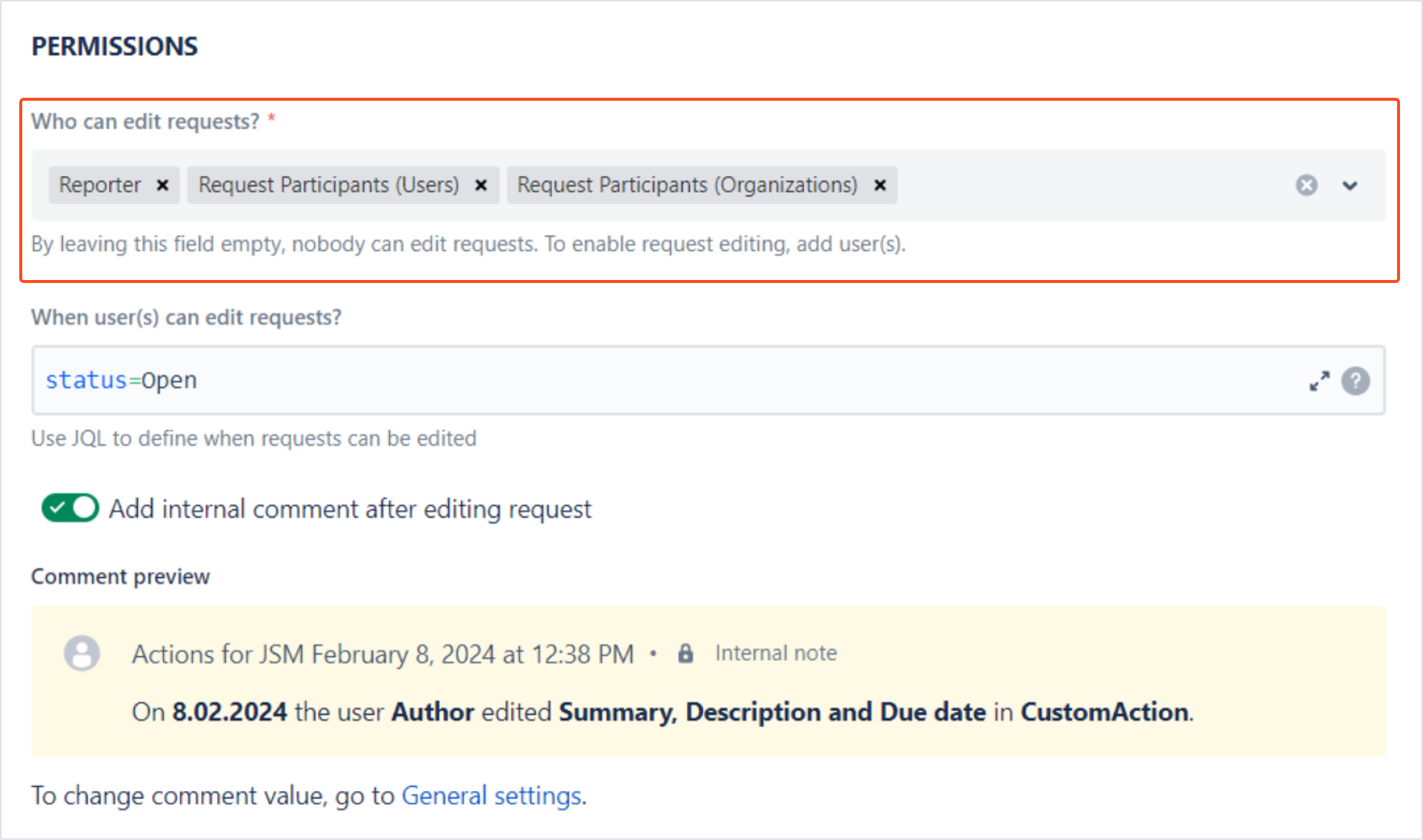Edit forms
See how to create and configure Edit forms.
Before you start, log in as a user with Jira Administrators project permissions. For more information, see Atlassian documentation.
Edit forms are designed to allow users to edit requests. They can be customized and displayed on your Customer Portal.
By setting the configuration of Edit forms, you can adjust the editing of requests to your customers’ needs. Create a branded title that will be displayed on the Customer Portal, select particular request types or fields for editing, and decide when and by whom requests can be edited.
Creating and Configuring
Steps
- Go to the Project settings section.
- Select the Request actions option.
- Click Add Edit form.

- You are redirected to the Configuration view. Design the content of your Edit form by determining:
The fields marked with an asterisk must appear on your Edit form, that’s why it is required to fill in such fields.
By clicking Cancel, the configuration of your Edit form can be permanently deleted.
Edit form title
Give your Edit form a name. Your Edit form’s title will be visible to users on the Customer Portal. The title will be displayed on the request’s Edit form, and you will also see it in Jira as the name of the Edit form’s configuration.
Optionally, you can add a description of your Edit form. Create a text which will contain up to 250 characters.
Customize the title of your Edit form by adding an emoji. There are several ways you can do it:
- Access emojis through the right mouse button using the Emoji option (on Windows).
- Use the Windows logo key + period (.) combination (on Windows).
- Use the Fn + E combination (on Mac).
- Use an external emoji copy tool.

Fields
You can select which fields are editable on requests, organize them in the preferred sequence, and determine which ones are required. To pick a specific field, choose one from the dropdown or begin typing its name and then click it.
Required fields are, by default, determined by the project settings. You can select the Make required option to overwrite the project settings and ensure the field will be displayed as required.
When selecting more than one field, you can use drag and drop to modify the order of the fields that will be presented on the Customer Portal.

Request types
Click the expand arrow icon on the Which request types can be edited field to choose which types of requests should be available for editing.

Permissions
Decide who can edit requests
Grant edit permissions to relevant users by clicking the expand arrow icon on the Who can edit requests field and selecting user(s) for whom editing of requests will be enabled. There are three user groups to be selected:
- Reporters
- Request Participants (Users)
- Request Participants (Organizations)

By granting edit permissions, you can select more than one user group.
To revoke edit permissions from a particular user group, click the cross icon next to the unwanted user group.
Determine when requests can be edited
To decide when user(s) can edit requests, use JQL to write queries.

Your JQL queries are automatically verified. An incorrect JQL query is marked in red.
If you want to learn more about JQL, take a look here.
Control editing with comments
The option to enable internal comments after editing of requests is by default switched off. To control editing with comments, use the toggle.
Turn on the toggle to enable the Add internal comment after editing requests option. You will be able to track all updates of requests, as every request’s editing will be followed by an internal comment. The comment will be visible to Jira Agents only.

You can use the default comment message or edit its content by accessing Global Configuration.
To create a personalized comment message, introduce the content of your message. You can include the following variables:
- Fields
- Editor
- Date
- Action Name
You can always check the introduced values and see a preview of the internal comment message which will be displayed on an issue in Jira.
Next up
Once your first Edit form has been created and configured, you can manage its settings and use it to allow customers for editing requests on your Customer Portal.
If you can’t find the answer you need in our documentation, raise a support request.
Include as much information as possible to help our support team resolve your issue faster.
